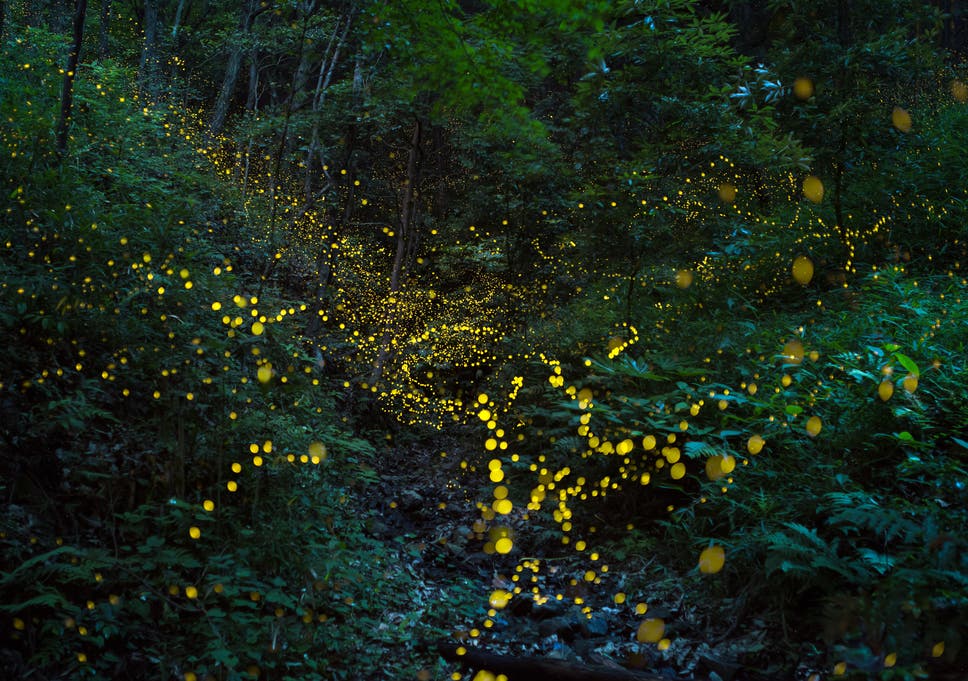Biodiversity crisis: Habitat loss, pesticides and light pollution pushing fireflies to extinction, scientists warn
‘Warning bell’ for species as vulnerable ecosystems record impact of heavy industry
‘Warning bell’ for species as vulnerable ecosystems record impact of heavy industry
Harry Cockburn Tuesday, 4 February, 2020

Gleaming clouds of fireflies glow in a forest at dusk ( Getty )
Fireflies, of which there are more than 2,000 species strobing softly throughout dark corners of the world, are facing grave threats to their continued existence due to the impact of humans, a study suggests.
Habitat loss, pesticide use and artificial light are three of the most serious threats to fireflies, with certain species more at risk than others.
The widespread insects are soft-bodied beetles remarkable for their enchanting use of bioluminescence during twilight to attract mates or prey.
The health of firefly populations helps illustrate the impact humans have on sensitive ecosystems.
To better understand what threats are faced by fireflies, a team led by Professor Sara Lewis at Tufts University, Massachusetts, alongside the International Union for the Conservation of Nature, surveyed firefly experts around the world to assess the most prominent threats to survival for their local species.
Species to be protected by "blue belt" conservation zones
The research, published in the journal Bioscience, “sounds a warning bell” about the insects’ future, highlighting specific threats and the vulnerability of different species across geographical regions.
According to survey respondents, habitat loss is the most critical threat to firefly survival in the majority of geographic regions, followed by light pollution and pesticide use.
“Lots of wildlife species are declining because their habitat is shrinking,” said Professor Lewis.
“So it wasn’t a huge surprise that habitat loss was considered the biggest threat. Some fireflies get hit especially hard when their habitat disappears because they need special conditions to complete their life cycle. For instance, one Malaysian firefly (Pteroptyx tener), famous for its synchronised flash displays, is a mangrove specialist.”
Drastic declines have recently been recorded in this species after the destruction of their mangrove habitat to make way for palm oil plantations and aquaculture farms.
Across the world, light pollution was regarded as the second most serious threat to fireflies.
Artificial light at night has grown exponentially during the last century.
“In addition to disrupting natural biorhythms – including our own – light pollution really messes up firefly mating rituals,” said Avalon Owens, a co-author of the research paper.
Many fireflies rely on bioluminescence to find and attract their mates, and previous work has shown too much artificial light can interfere with these courtship exchanges. Switching to energy efficient, overly bright LEDs is not helping.
“Brighter isn’t necessarily better,” Ms Owens said.
The firefly experts also said the widespread use of pesticides in agriculture was another key threat to firefly survival.
Most insecticide exposure occurs during larval stages, because juvenile fireflies spend up to two years living below ground or under water.
Insecticides such as organophosphates and neonicotinoids are designed to kill pests, yet they also have off-target effects on beneficial insects. While more research is needed, the evidence suggests many commonly used insecticides are harmful to fireflies.
The paper acknowledges previous studies which have quantified firefly population declines, such as those seen in the tourist-attracting synchronous fireflies of Malaysia, and the glowworm Lampyris noctiluca in England.
Numerous anecdotal reports suggest that many other firefly species across a wide range of habitats have also suffered recent declines.
“We really need better long-term data about firefly population trends. This is a place where citizen science efforts like Massachusetts Audubon’s Firefly Watch project can really help,” said Professor Lewis.
The researchers also highlighted risk factors that allow them to predict which species will be most vulnerable when faced with threats like habitat loss or light pollution. For instance, females of the Appalachian blue ghost firefly (Phausis reticulata) are flightless.
“So when their habitat disappears, they can’t just pick up and move somewhere else,” said co-author J Michael Reed, professor of biology at Tufts.
Despite the verdict the researchers remain optimistic about fireflies’ future.
“Here in the US, we’re fortunate to have some robust species like the Big Dipper fireflies (Photinus pyralis),” said Professor Lewis.
“Those guys can survive pretty much anywhere, and they’re beautiful, too.”
By illuminating these threats and evaluating the conservation status of firefly species around the world, researchers aim to preserve the magical lights of fireflies for future generations to enjoy.
“Our goal is to make this knowledge available for land managers, policy makers, and firefly fans everywhere,” said co-author Sonny Wong of the Malaysian Nature Society.
“We want to keep fireflies lighting up our nights for a long, long time.”
Blinded by the light, firefly species face extinction
 TUFTS UNIVERSITY/AFP / Jason STEELFireflies are beetles that glow to attract a mate
TUFTS UNIVERSITY/AFP / Jason STEELFireflies are beetles that glow to attract a mate
Fireflies are in deep trouble, with many species facing extinction due to habitat loss and exposure to pesticides, according to the first major review of their global status, published Monday.
Adding irony to injury, one of Nature's most entrancing spectacles is also being snuffed out by artificial light pollution, researchers reported in the journal BioScience.
More than 2,000 species of fireflies -- which are, in fact, beetles -- illuminate wetlands, marshes, grasslands, forests and urban parks worldwide.
A few, such as the Big Dipper in the United States, seem to be flourishing.
"Those guys can survive pretty much anywhere," said Sara Lewis, a biologist at Tufts University in Massachusetts and lead author of the study, based on a survey of dozens of firefly experts.
But other varieties -- from the glowworms of southern England to Malaysia's synchronous fireflies and the Appalachian blue ghost, both of which draw tourists -- are being extinguished by humanity's ever-expanding ecological footprint.
 AFP/File / STRArtificial light, habitat loss and pesticides pose a grave threat to firefly species
AFP/File / STRArtificial light, habitat loss and pesticides pose a grave threat to firefly species
"Some species get hit especially hard by habitat loss because they need specific conditions to complete their life cycle," said Lewis.
The Malaysian firefly Pteroptyx tener, for example, lives during its larval phase in riverside mangroves, many of which have been ripped up to make way for palm oil plantations and fish farms.
The glowworm (L. noctiluca) has another problem -- females are flightless, which means that can't simply buzz off to a new location when their habitat is swallowed by a suburb, commercial crop or country road.
Other species of fireflies, which eat only during their larval phase, are "dietary specialists," meaning they subsist on one or two kinds of snail, earthworm or other soft-bodied prey.
When fruit orchards in Mediterranean Spain are abandoned or give way to urbanisation, so too do the snails preferred by aptly named Lampyris iberica, leaving the firefly larva nothing to eat.
- 'Flashing through the gloom' -
Adult Pteroptyx in Malaysia, meanwhile, gather for nightly courtship displays in specific trees located along mangrove rivers. Many of those trees have been cut down.
Of 10 possible drivers of extinction, experts fingered habitat loss as the top threat everywhere -- except east Asia and South America.
In those two regions, artificial light was seen as the biggest menace to the world's luminescent beetles.
"In addition to disrupting natural biorhythms, light pollution really messes up firefly mating rituals," said co-author Avalon Owens, a doctoral student at Tufts.
Many species of firefly depend on their ability to light up to find and attract mates.
 TUFTS UNIVERSITY/AFP/File / RADIM SCHREIBEROne of Nature's most entrancing spectacles -- fireflies -- is also being snuffed out by artificial light pollution
TUFTS UNIVERSITY/AFP/File / RADIM SCHREIBEROne of Nature's most entrancing spectacles -- fireflies -- is also being snuffed out by artificial light pollution
To make matters worse, that window of opportunity is very narrow: while the firefly larval phase lasts months to years, adults typically live only a few days.
The twinkling beetles are so focused on reproducing that they don't even eat.
The survey found that fireflies are also being decimated by commonly used insecticides, the third major threat.
"Organophosphates and neonicotinoids are designed to kill pests, yet they also have off-target effects on beneficial insects," the researchers wrote.
Fireflies light up by triggering a chemical reaction –- involving oxygen, calcium and an enzyme called luciferase -- inside special organs in their abdomen, a process called bioluminescence.
Their otherworldly glow has been an enduring source of fascination.
But firefly tourism -- long popular in Japan, Malaysia and Taiwan -- has also taken a toll, with fragile ecosystems damaged by too much foot traffic.
The plight of fireflies at the beginning of the 21st century add a new layer of meaning to lines written more than a century ago by Canadian poet Bliss Carman.
"And the fireflies across the dusk, Are flashing signals through the gloom," he wrote.
While climate change is not seen as a current threat, future sea level rise and drought also could accelerate the drive towards extinction.
The dozen authors contributing to the study are all affiliated with the Firefly Specialist Group -- set up in 2018 -- of the International Union for the Conservation of Nature (IUCN), which compiles the Red List of threatened species.








